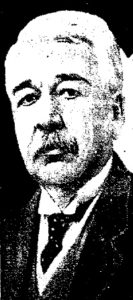
If old houses hold the memories of those who have lived in and visited them, this home at 3959 Warwick would have had more stories to tell than most. The home—now replaced by an apartment building—was the long-time residence of lawyer and prominent philanthropist Sanford Ladd, and in his waning years, it was the frequent site of parties that brought together the various threads of his life.
As part of our Uncovering History Project, the Midtown KC Post is examining each block in Midtown. A set of 1940 tax assessment photos is available for many blocks.
There is no 1940 photo of the Ladd home, but over the next few weeks, check back for more history of this block, McGee to Warwick between 39th and 40th.

When he died in 1937, Sanford Ladd’s obituary in the June 7, Kansas City Star called him “a gentleman lawyer.” It described him as a fluent speaker, prone to telling stories with a touch of humor in them, and a successful lawyer who had stood before the U.S. Supreme Court.
It also noted that, as Ladd taught law students, he remained dignified while also understanding “human foibles and most human pretensions.”
Like his home, Ladd remained rooted in the Victorian era. He was described as always perfectly dressed, with “spotless wing collar, flawlessly fitted suits,” and smoking a cigar from a holder, even after he became blind.
Who was this popular lawyer? Ladd attended the University of Michigan before coming to Kansas City to learn the legal profession by working in the trade. He later confessed he was not that impressed with the muddy roads, wooden buildings, and rickety sidewalks he found here in 1868. He worked at the law firm of Douglas & Gage, learning by doing office chores and eventually going to court, and quickly becoming one of the best-respected lawyers in Kansas City.
Along the way, Ladd learned to love the city around him and stayed here until his death.
Ladd became the president of the Missouri State Bar Association and the University Club and was once a Republican candidate for the state supreme court. He also served for about thirty years on the Kansas City School Board, which named the Sanford Ladd School at 37th and Benton after him
Looking out over Warwick from his library
Ladd’s library stood above the street, and he often entertained guests there. His Victorian home was “a model of hospitality—a shrine visited regularly by the legal profession of Kansas City,” a judge told The Star after his death. When it became hard for Ladd to travel to their annual meeting, the past presidents of the bar association started holding it at his house.
Ladd had also been the attorney for the Little Sisters of the Poor, so it was not uncommon for Bishop Lillis to drop by for a visit.
And Ladd enjoyed a yearly visit by a special group of young people. The students of Sanford Ladd school would bring him a birthday cake to celebrate his big day every year.
Historic photos courtesy Kansas City Public Library/Missouri Valley Special Collections.
I attended Sanford B. Ladd in the 40’s.
B. stands for Brown…..
Thanks–I wondered what the “B” stood for!
Sanford Ladd Elementary School was called Sanford B. Ladd. My brother, sister and I all attended Ladd back in the late forties and fifties. Across the street from Ladd was Buckley’s neighborhood grocery. Buckley’s had a long glass-enclosed counter with many varieties of penny candy. Hordes of kids descended on Buckley’s every day after school! Memories!
We 1954 “graduates” of Ladd have met several times for reunions in the last 2 or 3 years! After much research by several Laddites, lead by Peter Clark, we came up with about 40 Laddies and Lassies!
I really enjoy this post since I lived on Warwick Blvd. at 43rd. St. Ca. 1949 while attending Rollins Grade School from 4th. grade through 7th. Spent many a day pulling my Radio Flyer coaster wagon around collecting old newspapers for the school paper drive.
These were the post war years and vestiges of civilian saving various materials for the war effort were still in evidence. On the playground next to the Rollins School Bldg. was a plywood box painted red, white and blue. It served as a repository for used cooking grease that was needed for the mfg. of ammunition. Don’t think it was still being employed for this purpose however.
Some of the best years of my youth were spent in this midtown neighborhood …memories that will always stay with me.
My wife’s family bought the home and lived there until 1968. They sectioned it into apartments. they still have some of the interior odds and ends floating around in the family. leaded glass cabinets and a mantle for sure. my wife’s grandma grew up in that house and shes still around and sharper than most. Shed know it better than anyone alive today.
My grandparents owned this house when I was young ( 1960s). Grandpa had made either 5 or 7 apartments in it and we weren’t allowed to go into them for the obvious reasons. I would love to find the architectual ‘plans’ to relive my fading memories. does anyone have any suggestions on where I might find that ?
Pingback: Dinner for 100 on this Southermoreland block - Uncovering History Project